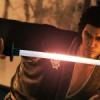Ryuu ga Gotoku, known as Yakuza in the West, has become a flagship series for Sega. The action-adventure crime-saga meets character-drama started out on the PlayStation 2 in 2005, and since the success of Yakuza 3 the franchise has seen (almost) yearly installments in Japan.
But sales figures in the West have been less than encouraging, leaving Sega unwilling to commit to the localization of a number of Japan-only Yakuza games. Among them are two samurai-tastic spin-offs, the recent Yakuza Restoration, and Yakuza Kenzan!
Kenzan! was the first Yakuza game on the PS3, an experiment conceived as a stop-gap to tide over the fanbase and give the developer time to experiment with the PS3 hardware in preparation for work on Yakuza 3.
The result of that experiment is a fun little game that’s unsure of which console generation it belongs to. Think Yakuza 2.5, albeit with an interesting setting – 17th Century Japan- and new characters, motiffed on characters from the series past.
The story is based on the legend of Miyamoto Musashi. The legend goes that Miyamoto Mushashi was a samurai who started from nothing and rose to become a powerful, influential figure. Filled with dreams of becoming a powerful samurai, Musashi is unable to refuse an invitation to join the military and prove his worth in battle. But things go wrong and Musashi becomes a wanted man - forced into hiding.
Now living as an outcast, Musashi assumes a new identity, living unassumingly - until one day fate intervenes. A girl comes to him with a request to track down and kill her parents’ murderer, a man called Miyamoto Musashi. Musashi, having no recollection of such a killing, sets out to find his doppelgänger.
Those not well-versed in the legend of Miyamoto Musashi needn’t worry; this fantastical take on the legend assumes no familiarity. Likewise, series newcomers can jump in here as the game is a self-contained, standalone episode. Though keeping in-line with the series the story is a steamy bromance based around themes such as friendships forged in battle, finding ‘someone stronger’ - only this time with samurai-genre cheese like fighting for honor.
Kenzan! marked a shift from the static camera angles of the previous games; the first in the series with a fully-controllable third-person camera, a change that helps immerse the player in their surroundings. And Kenzan! is at its best when its selling you on its surroundings; the sense of oppression in vertical society, the importance of one’s standing, the treatment of women in the red light districts. Rubbernecking the dregs of medieval Japan is one of the best parts of Kenzan! even if all the back-tracking - which even fast tracking doesn’t entirely alleviate - makes seeing the sights game-clock-bloatingly inconvenient.
Second to soaking in the atmosphere of feudal Japan is combat. In keeping with the setting you’ll be fighting with a combination of swords. There are four fighting styles; The fast bare-handed style which leaves you open to sword attacks; the single katana style, boasting a good balance of speed and power; the two-katana style which is weak but allows omni-directional blocking; and the broadsword style which allows you to heft around massive weapons, flattening your enemies.
But combat isn’t as varied or deep as the four-style system might lead you to believe. This is in part down to the levelling-up system. In Kenzan! character growth isn’t tied to combat versatility; you level up linearly, and there’s no system to assign experience points towards different attributes or skills. Of the skills you do learn, the majority simply enhance already-learned moves within each style, rather than giving the styles more utility. Since their existing moveset becomes more effective over time, the player develops a playstyle bias - making combat routine in the end-game.
Part of the fault lies with the stripping-out of combat strategy. The Heat gauge builds as you dish out damage: get it up high enough, and you’re granted access to some of the bone-crunching nonsense that the series is known for. The Heat Gauge, a series staple, tasks players with choosing between cashing in Heat immediately for instant ass-kicking, or persevering until they’ve built up the next level of meter, gaining access to even more ass-kicking techniques.
Kenzan! removes the either/or from the decision making process; the triangle button pulls off an anime-esque enemy crumple (complete with badass pose - see above), you can stock heat with wanton gluttony for as long as you keep the button held down. The simplified levelling structure and removal of Heat management strategy make Kenzan! feel simplified and arcade-y against its already arcade-y predecessors.
Although the four fighting styles offer different ways to dispatch enemies, transitions between them are slow and clunky, necessitating having to messily disperse enemies to create the breathing room needed to switch – it’s easier to just stick to the same old style for prolonged lengths of time – so you will.
But at the very least, whichever style you choose to lacerate your foes with it will feel right, thanks to clear hit-confirmation sound effects and bright orange cut marks that score enemy bodies on contact; you get very clear audio-visual feedback as to whether you are hitting, and how hard. Combat remains kinaesthetically satisfying even when it’s shallow and routine. The player will approach the game as a story with ancillary game elements, rather than a holistic experience where each part, such as combat, is interesting in and of itself.
The story builds intrigue by introducing new characters, plot threads and taking the time to illuminate the back stories and motivations of the supporting cast. Speaking of the supporting cast, there are points where their samurai rationale of doing
things is difficult to empathize with; by the end of the game some of the characters’ machismo reduces them to caricatures of themselves.
Sadly, although the game builds intrigue well and does an admirable job motivating the player onwards, the final reveal comes across as a limp formality to tie up all the loose ends. Intrigue works best by building anticipation through glimpses, and then trumping anticipations with the reveal. This reveal has the gusto of air wheezing out of a deflating balloon, when it needed to be a fireworks display.
The presentation of the story is also spotty. The game dips and back and forth between gorgeous high quality cinemas and lower-quality in-game assets. The result can be a little jarring. Every time there is a major plot revelation you can count on the graphics scaling back so the characters can natter away in low-fidelity for a few minutes, until they reach a major plot point - at which point a high-quality pre-render will kick in again. Sometimes this happens several times within a single conversation. Presentation blemishes make Kenzan! feel as though it hasn’t fully crossed the generation traverse between the PS2 and PS3.
NPC dialogue is delivered in text, load-screens break up indoor and outdoor areas and sometimes even outdoor areas are separated from each other by load screens. One fight takes place across series of field clearings, each one taking place in its self-contained shoebox. Even basic physics are absent; materials like flags which you would expect to be able to walk through impede your progress as if they were made of sheet metal.
Yakuza: Kenzan! doesn’t feel like a PS3 Yakuza game, more like an appetizer of what a PS3 Yakuza could be; a tease of potential. The swordplay feels sharp, but plays dumb. The story motivates during pre-amble but the anti-climactic reveal fails to impress. And the graphics demonstrate how the PS3 hardware could realize a detailed world, but it’s a world with very apparent seams. Years after Kenzan!, Yakuza Restoration would take a lot of this unrealized potential and sharpen it into a brilliant game. But as it stands, Kenzan! is simply a decent way to lavish 18 hours on bromantic swordplay.










